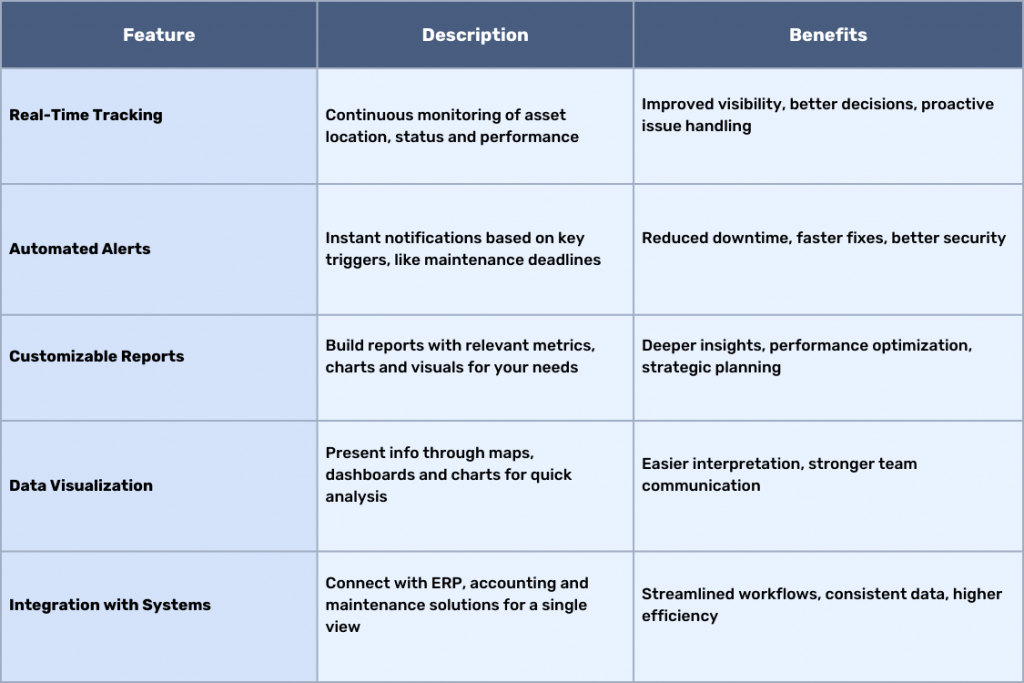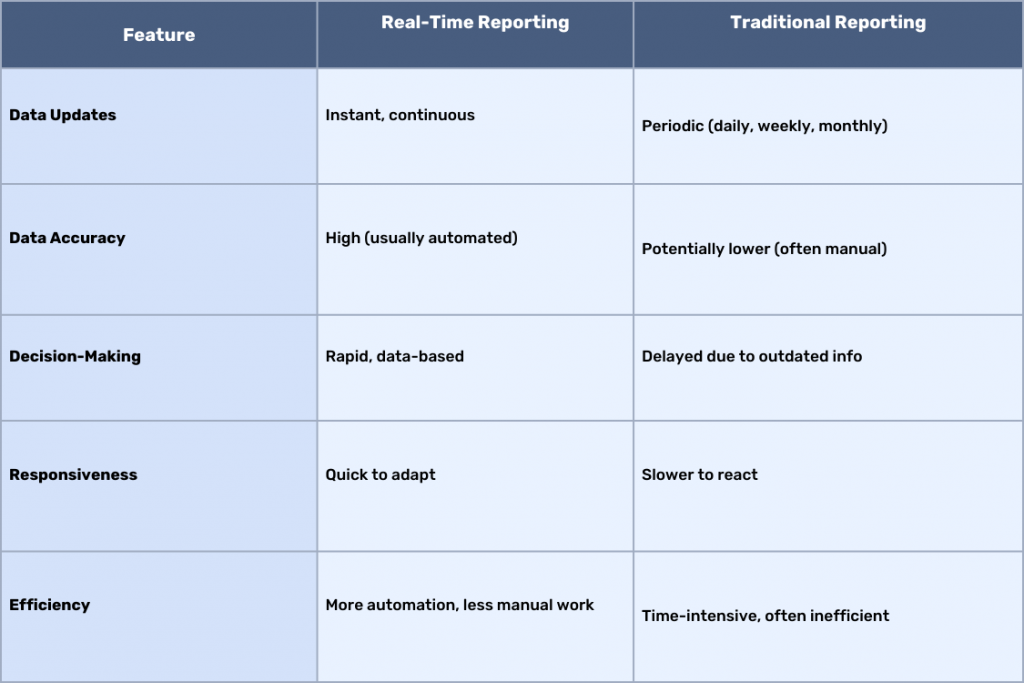IoT Solutions

Real-time asset reporting is changing the game for how businesses track and manage their valuable resources. In this overview, we’ll look at what real-time asset reporting for businesses actually is, why it matters so much in today’s fast-paced world and how recent technologies—like IoT sensors, cloud platforms and solutions from providers like Mapsted—are pushing its capabilities to new heights.
Real-Time Asset Reporting: A Definition
Real-time asset reporting involves gathering and analyzing up-to-the-minute data about an organization’s assets, from equipment and machinery to inventory and even personnel. Traditional reporting methods usually rely on periodic or manual updates, but real-time asset reporting for businesses gives you a continuously updated picture of where assets are, how they’re performing and which ones need attention. This kind of immediate feedback helps businesses:
- Make informed decisions quickly
- Optimize resource use
- Reduce operational inefficiencies


In many setups, real-time data comes from GPS trackers, asset tags or sensors that feed into other business tools like ERP systems. With advancements in real-time asset tracking, organizations now prefer to integrate advanced solutions like Mapsted’s Tag (for asset tracking) or Badge (for workforce monitoring. This is to see, at a glance, the status of their entire asset ecosystem—with minimal hardware requirements.
Keep in mind that some “real-time” systems still update in intervals. But even these semi-continuous updates tend to be much faster than waiting for, say, monthly or quarterly reports. In finance, for example, real-time trade reporting is a regulatory must, making transactions visible to the public as soon as they happen. Just like real-time trade reporting ensures instant transparency in finance, continuous asset tracking gives you real-time or every-minute status on your assets, helping you make quick and smarter decisions.
Real-Time Reporting for Businesses: Key Takeaways
In markets that change overnight and consumers expect quick responses, real-time reporting gives companies an edge. Below are the benefits of real-time reporting that help businesses stay competitive
1. Improved Decision-Making
When you have current data at your fingertips, there’s no waiting around or relying on last month’s stats. Real-time insights help you spot trends, tweak pricing and respond to customer demands on the fly.
2. Enhanced Operational Efficiency
Real-time visibility into asset location and utilization helps teams address problems quickly. For instance, Mapsted’s Flow solution provides real-time heat mapping of traffic flow, which can help you see where bottlenecks occur in a facility, so you can adjust staffing or shift assets to the right place at the right time.
3. Increased Transparency and Accountability
Knowing exactly where things are and when they move fosters a sense of responsibility. Whether it’s your warehouse team, your retail staff or a field service technician, everyone knows the system is tracking asset movement and performance in real time. Hence, there’s a sense of responsibility in addition to the ease of finding assets that can be utilized by anyone in need.
4. Better Customer Satisfaction
Real-time data means you can respond to customer requests faster. In logistics, for instance, tracking deliveries in real time can drastically cut down on wait times and guesswork.
5. Competitive Advantage
Any business needs to be able to change direction based on new information. Companies that act quickly are different from those that wait weeks or months for updates because they use real-time reporting.
6. Improved Compliance and Risk Management
With real-time alerts and automated triggers, you can catch issues like asset misplacement, usage violations or anomalies before they snowball into bigger problems.
How Real-Time Reporting Drives Business Growth
One of the best ways to see how real-time reporting drives growth is by looking at real-world applications:
- Optimized Inventory Management
Real-time inventory tracking helps you keep just the right amount of stock. Less overstock, fewer stockouts and happier customers. - Streamlined Supply Chain
Having real-time data on asset location and condition means fewer blind spots. This transparency speeds up deliveries and cuts down on logistics costs. - Personalized Customer Experience
Real-time reporting can also capture customer preferences and behaviours—great for retailers who want to tailor promotions and store layouts. For deeper analytics, you could layer in location-based insights from solutions like Mapsted’s Flow, which highlights where customers spend most of their time. - Data-Driven Decision Making
When you can see what’s happening this minute, you can make strategic adjustments quickly. Combine real-time data with historical metrics for a full-spectrum view of past trends and current conditions. - Agility and Responsiveness
Real-time info makes organizations more flexible, which helps them adapt to market changes quickly. The result is a more innovative culture that’s open to experimentation and continuous improvement.
A Closer Look at Real-Time Inventory Tracking Systems
Real-time inventory tracking is a key part of real-time asset reporting for businesses. Using barcode scanning, RFID tags, or even Mapsted’s Tag solution, you get a live feed of what’s in stock, where it’s located and how quickly it’s moving. Some of the major benefits include:
- Avoiding Stockouts and Overstocks
Real-time data helps maintain just the right amount of inventory, which translates to cost savings and happier customers. - Better Order Fulfillment
Locate items fast, fulfill orders accurately and keep your fulfillment team in sync. - Reduced Shrinkage
Track all inventory movements so you can detect theft, damage, or misplacement early on. - Enhanced Supply Chain Visibility
Know exactly when shipments are delayed or stuck and then pivot resources accordingly.
Key Features of Real-Time Asset Reporting

Real-Time Reporting vs. Traditional Reporting
When comparing real-time reporting to older methods, the differences are stark:

While historical data is still crucial for long-term planning, layering in real-time insights gives you the best of both worlds: the ability to respond now, paired with the big-picture perspective you need for future strategies.
Real-Time Reporting Across Industries
- Manufacturing: Keep tabs on production lines, machine health and supply levels to reduce downtime.
- Transportation: Track vehicles and shipments in real time to make route planning and delivery times hassle-free.
- Healthcare: Quickly locate medical devices, optimize staffing and maintain proper inventory levels for quality patient care.
- Oil & Gas: Monitor pipelines and equipment conditions to boost safety and reduce environmental impacts.
- Retail: Get immediate feedback on stock levels and shopper behaviour to optimize product placement.
- Finance: Analyze live market trends and make swift, data-driven trading decisions.
Technological Requirements (and Challenges)
To implement real-time asset reporting, you need reliable data collection tools (e.g., sensors, GPS trackers) and robust software to process it. Cloud-based platforms have grown popular for these workloads because they can scale easily as your business expands. Some organizations also choose solutions like Mapsted’s minimal hardware IoT technology, which reduces extra infrastructure costs while still delivering precise, real-time insights.
Challenges might include:
- Data Accuracy: You will need to make sure that the data is correct and that there are no inconsistencies.
- Scalability: Systems should handle growing volumes of asset data.
- Security: Protecting sensitive data is critical, especially with real-time visibility across the board.
- Integration: Connecting with existing enterprise systems can be tricky, but it’s worth it to get a unified view.
- Costs: Investing in new hardware, software and integrations can be significant upfront, though the benefits often outweigh these costs long term.
Future Outlook: Where Real-Time Asset Reporting Is Headed
Looking ahead, technologies like AI, machine learning and IoT will continue to supercharge real-time asset reporting. We’re already seeing solutions that forecast potential issues before they happen—predictive maintenance, for example—while Mapsted’s IoT and location-based platforms are showcasing how minimal-hardware technology can simplify deployment and reduce costs.
Some exciting trends to watch:
- AI & Machine Learning: More automated data analysis, anomaly detection and predictive intelligence.
- IoT Connectivity: More sensors and devices offering highly granular data in real time.
- Blockchain: Potential for even more secure and transparent asset tracking.
- Cloud & Edge Computing: Balancing data processing between cloud servers and localized (edge) networks for faster responses.
Conclusion
Real-time asset reporting has quickly become a cornerstone for businesses that want to stay agile, efficient and competitive. Whether you’re optimizing inventory, streamlining supply chains, or improving customer experiences, having real-time data is the key Solutions like Mapsted’s Tag, Flow or Badge can fit smoothly into an existing ecosystem, enhancing visibility without piling on complicated hardware requirements.
By combining real-time reporting with historical analysis, organizations get the best of both worlds—up-to-the-minute insights for immediate actions and deeper context for strategic, long-term decisions. If you found this blog insightful, check out our post on What are the Top Ways to Use Customer Insights for Growth and Customer Retention? or watch our video on How To Gain Deeper Customer Insights With Mapsted Audience Segmentation to learn more.
Frequently Asked Questions
Q1: How does real-time asset reporting differ from traditional reporting?
A: Real-time asset reporting provides current resource data. Real-time reporting tracks location, performance and status using sensors, GPS trackers, or platforms like Mapsted, unlike manual updates. This live data stream helps businesses identify issues early, make faster decisions and be more efficient.
Q2: How does real-time asset reporting optimize business costs?
A: Real-time reporting shows inefficiencies and improvement opportunities by tracking asset usage and locations. With real-time insights, businesses can cut overstock, downtime and maintenance costs. The operation becomes leaner and cheaper.
Q3: What assets are real-time monitorable?
A: Inventory, vehicles, machinery and personnel can be tracked. Mapsted’s Badge solution tracks workforce location, while their Tag solution tracks equipment and inventory, providing real-time movement and usage updates without hardware.
Q4: Is real-time asset reporting compatible with business systems?
A: Yes. Many real-time asset reporting tools integrate with ERP, accounting and maintenance software to centralize operations. This integration ensures data consistency across departments and the real-time, latest information for decision-making.
Q5: Is real-time asset reporting costly or complicated?
A: Costs and complexity depend on goals and infrastructure. Newer systems, like Mapsted’s, don’t need beacons or Wi-Fi, saving money upfront and over time. Most companies find that efficiency and cost savings quickly outweigh the initial investment.
